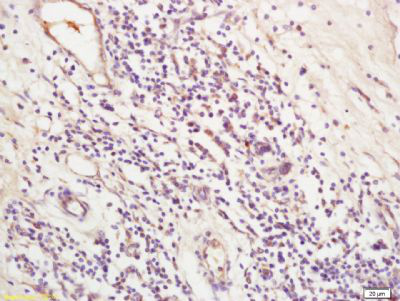产品货号 : mlR6544
英文名称 : LOXL2
中文名称 : 赖氨酰氧化酶相关蛋白2抗体
别 名 : LOR 2; LOR2; LOX L2; LOXL 2; LOXL2; LOXL2_HUMAN; Lysyl oxidase homolog 2; Lysyl oxidase like 2; Lysyl oxidase like protein 2; Lysyl oxidase related 2; Lysyl oxidase related protein 2; Lysyl oxidase related protein WS9 14; Lysyl oxidase-like protein 2; Lysyl oxidase-related protein 2; Lysyl oxidase-related protein WS9-14; WS9 14.
研究领域 : 肿瘤 细胞生物 免疫学 信号转导 细胞骨架 肿瘤细胞生物标志物
抗体来源 : Rabbit
克隆类型 : Polyclonal
交叉反应 : Human, Mouse, Rat, Chicken, Dog, Pig, Cow, Horse, Rabbit,
产品应用 : ELISA=1:500-1000 IHC-P=1:400-800 IHC-F=1:400-800 IF=1:100-500 (石蜡切片需做抗原修复)
not yet tested in other applications.
optimal dilutions/concentrations should be determined by the end user.
分 子 量 : 87kDa
细胞定位 : 细胞外基质 分泌型蛋白
性 状 : Lyophilized or Liquid
浓 度 : 1mg/ml
免 疫 原 : KLH conjugated synthetic peptide derived from human LOXL2:621-720/774
亚 型 : IgG
纯化方法 : affinity purified by Protein A
储 存 液 : 0.01M TBS(pH7.4) with 1% BSA, 0.03% Proclin300 and 50% Glycerol.
保存条件 : Store at -20 °C for one year. Avoid repeated freeze/thaw cycles. The lyophilized antibody is stable at room temperature for at least one month and for greater than a year when kept at -20°C. When reconstituted in sterile pH 7.4 0.01M PBS or diluent of antibody the antibody is stable for at least two weeks at 2-4 °C.
PubMed : PubMed
产品介绍background:
This gene encodes a member of the lysyl oxidase gene family. The prototypic member of the family is essential to the biogenesis of connective tissue, encoding an extracellular copper-dependent amine oxidase that catalyses the first step in the formation of crosslinks in collagens and elastin. A highly conserved amino acid sequence at the C-terminus end appears to be sufficient for amine oxidase activity, suggesting that each family member may retain this function. The N-terminus is poorly conserved and may impart additional roles in developmental regulation, senescence, tumor suppression, cell growth control, and chemotaxis to each member of the family. [provided by RefSeq, Jul 2008].
Function:
Mediates the post-translational oxidative deamination of lysine residues on target proteins leading to the formation of deaminated lysine (allysine). When secreted in extracellular matrix, promotes cross-linking of extracellular matrix proteins by mediating oxidative deamination of peptidyl lysine residues in precursors to fibrous collagen and elastin. Acts as a regulator of sprouting angiogenesis, probably via collagen IV scaffolding. When nuclear, acts as a transcription corepressor and specifically mediates deamination of trimethylated 'Lys-4' of histone H3 (H3K4me3), a specific tag for epigenetic transcriptional activation. Involved in epithelial to mesenchymal transition (EMT) via interaction with SNAI1 and participates in repression of E-cadherin, probably by mediating deamination of histone H3. Also involved in E-cadherin repression following hypoxia, a hallmark of epithelial to mesenchymal transition believed to amplify tumor aggressiveness, suggesting that it may play a role in tumor progression. Acts as a regulator of chondrocyte differentiation, probably by regulating expression of factors that control chondrocyte differentiation.
Subunit:
Component of some chromatin repressor complex. Interacts with SNAI1.
Subcellular Location:
Secreted, extracellular space, extracellular matrix, basement membrane (By similarity). Nucleus. Chromosome. Note=Associated with chromatin. It is unclear how LOXL2 is nuclear: it contains a clear signal sequence and is predicted to localize in the extracellular medium. However, different reports confirmed the intracellular location and its key role in transcription regulation.
Tissue Specificity:
Expressed in many tissues. Highest expression in reproductive tissues, placenta, uterus and prostate.
Post-translational modifications:
The lysine tyrosylquinone cross-link (LTQ) is generated by condensation of the epsilon-amino group of a lysine with a topaquinone produced by oxidation of tyrosine. [PTM] N-glycosylated. N-glycosylation on Asn-455 and Asn-644 may be essential for proper folding and secretion; may be composed of a fucosylated carbohydrates attached to a trimannose N-linked glycan core.
Similarity:
Belongs to the lysyl oxidase family.
Contains 4 SRCR domains.
SWISS:
Q9Y4K0
Gene ID:
4017
Important Note:
This product as supplied is intended for research use only, not for use in human, therapeutic or diagnostic applications.
Post-translational modifications:
The lysine tyrosylquinone cross-link (LTQ) is generated by condensation of the epsilon-amino group of a lysine with a topaquinone produced by oxidation of tyrosine.
产品图片












